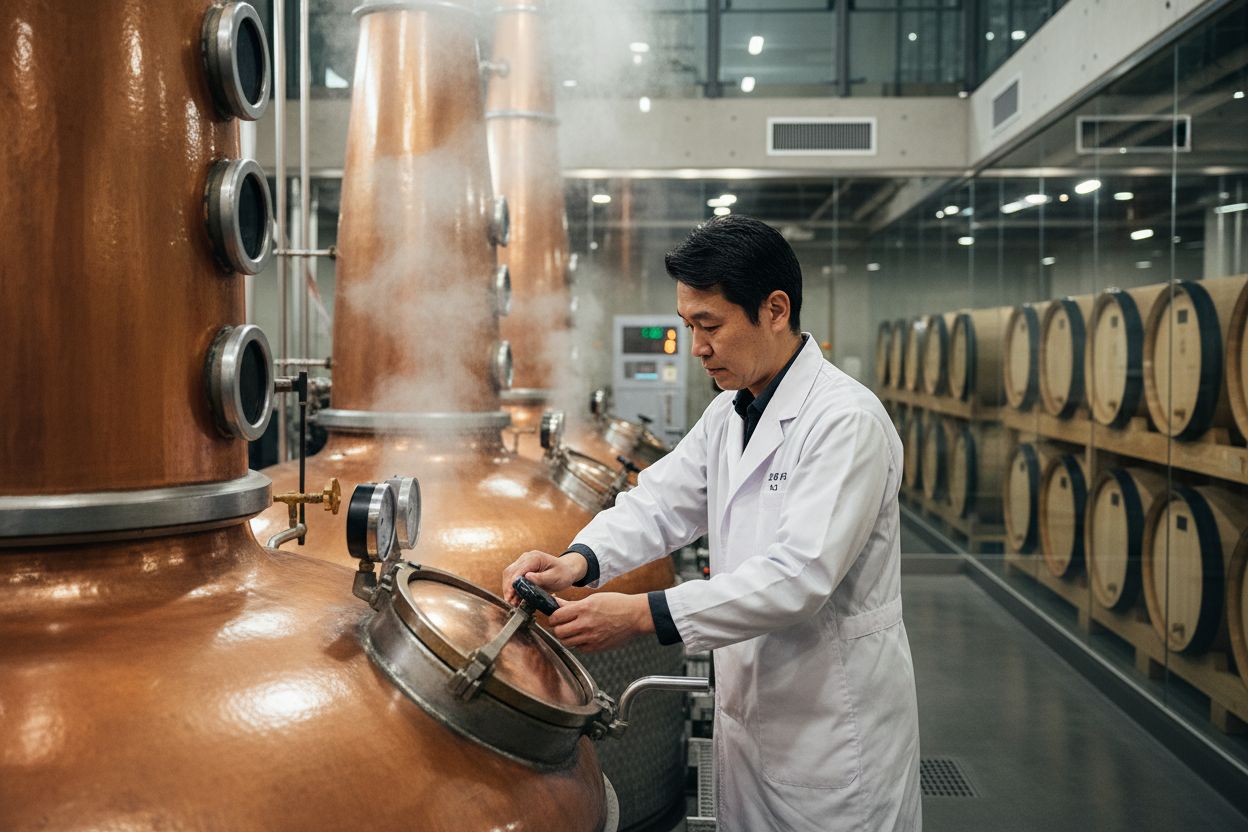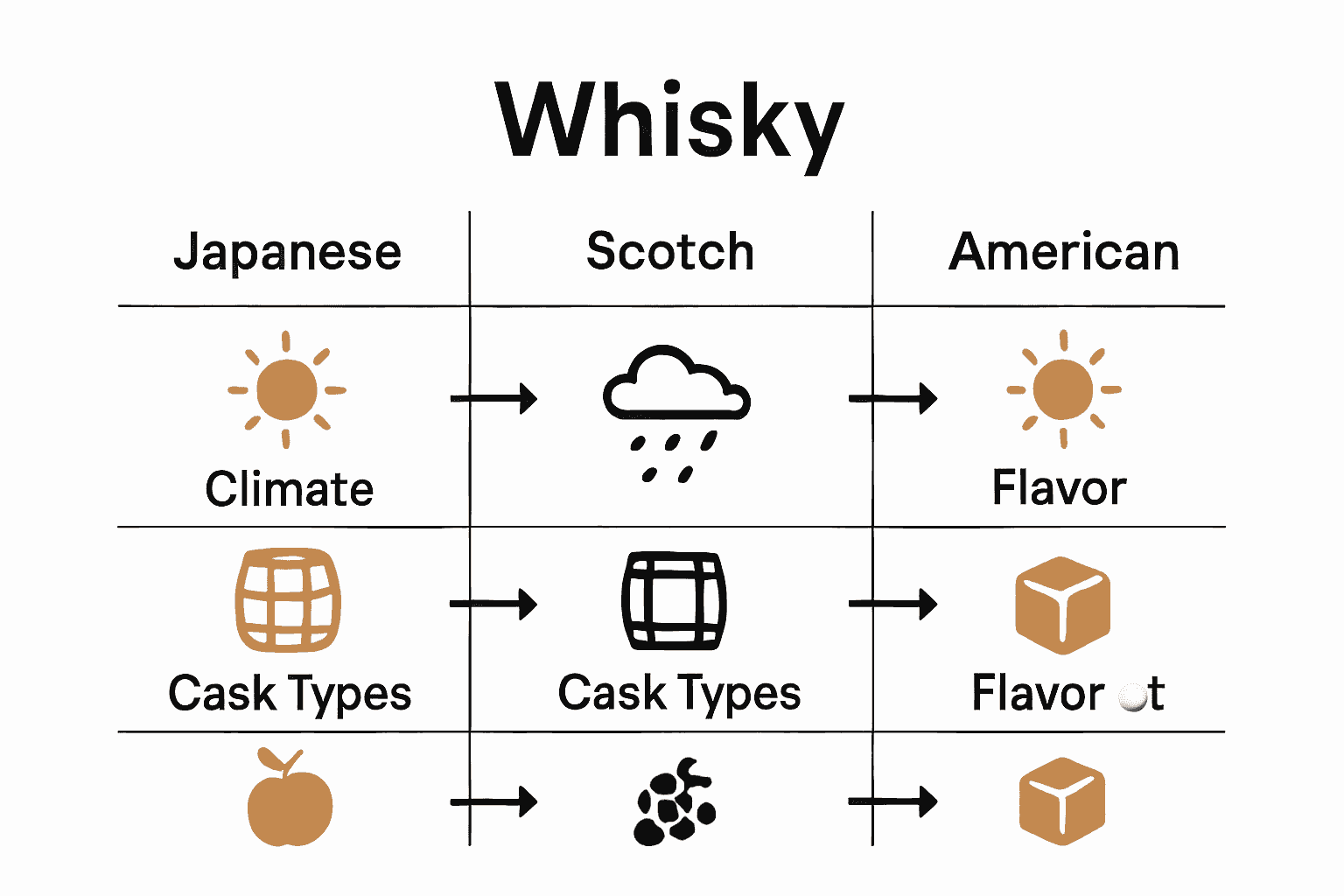Over the past decade, Japanese whisky exports have soared by over 200 percent, placing these once-hidden gems squarely on the world stage. For enthusiasts and collectors alike, the story of Japanese whisky is far more than a tale of imitation. It is a journey shaped by remarkable craftsmanship, unique climate influences, and a fierce dedication to detail that transforms every bottle into a work of art. Understanding this spirit reveals why it continues to captivate taste buds and command attention worldwide.
Table of Contents
- Defining Japanese Whisky and Its Origins
- Distinct Production Techniques and Influences
- Signature Flavors and Tasting Profiles
- Varieties and Regional Differences Within Japan
- Comparing Japanese Whisky to Global Styles
- Collecting, Rarity, and Global Demand Trends
Key Takeaways
| Point | Details |
|---|---|
| Japanese whisky combines Scottish tradition with Japanese innovation. | Using local ingredients and traditional techniques, it has evolved into an art form that reflects Japan’s cultural sensibility. |
| Distinctive production techniques contribute to unique flavors. | Methods such as mizunara oak aging and coal-fired stills create complex flavor profiles, enhancing the whisky’s character. |
| Regional diversity shapes unique whisky characteristics. | Different areas, like Tohoku and Kanto, produce distinct styles that embody their local terroirs, enriching the overall Japanese whisky landscape. |
| Growing global demand reflects its premium quality. | The rarity and craftsmanship of Japanese whiskies have made them highly collectible, as evidenced by soaring auction prices and expanding export markets. |
Defining Japanese Whisky and Its Origins
Japanese whisky is a distinctive spirit with roots deeply intertwined in Scottish tradition and Japanese craftsmanship. According to research from Nippon, early Japanese distillers adopted copper pot stills and oak maturation techniques directly from Scotland, while simultaneously infusing their own unique cultural approach to brewing and distillation.
The story of Japanese whisky begins in the early 20th century with two pioneering figures: Shinjiro Torii and Masataka Taketsuru. As documented by Wikipedia, Torii established the Yamazaki distillery in 1923, strategically selecting Kyoto’s exceptional water and climate for whisky production. Taketsuru, who had trained in Scotland, later founded Nikka and played a crucial role in establishing the foundational techniques of Japanese whisky making.
What sets Japanese whisky apart is its meticulous attention to detail and respect for natural elements. Distillers incorporated distinctive local ingredients like mizunara oak for barrel aging and drew inspiration from traditional sake brewing techniques. These elements transformed whisky production from mere replication to a sophisticated art form that honors both international methods and Japanese cultural sensibilities. Learn more about Japanese whisky styles in our comprehensive guide.
Today, Japanese whisky is recognized globally for its precision, complexity, and extraordinary craftsmanship - a testament to those early innovators who dared to reimagine a traditional European spirit through a uniquely Japanese lens.
Distinct Production Techniques and Influences
Japanese whisky production represents an extraordinary blend of scientific precision and artistic craftsmanship. According to research from Nippon, these distilleries leverage geographic and climatic diversity to create truly exceptional spirits, with techniques that set them apart from traditional whisky-making approaches.
Production methods showcase remarkable attention to detail. As documented by Best Whiskey Guide, Japanese distilleries adhere to strict regulatory requirements, including maintaining a minimum of 40% alcohol by volume (ABV) and ensuring bottling occurs within Japan. Their techniques include using high-quality spring water, experimenting with diverse grains like rice, and employing multiple distillation styles that demonstrate remarkable innovation.
Unique production elements distinguish Japanese whisky from its global counterparts. For instance, some distilleries like Yoichi use traditional coal-fired stills, which impart distinct flavor profiles impossible to replicate with modern equipment. The incorporation of mizunara oak casks - a native Japanese wood - introduces complex, subtle flavors ranging from sandalwood to coconut that are unmistakably Japanese. These distilleries also draw significant inspiration from sake brewing techniques, applying centuries of fermentation expertise to whisky production. Discover how to enjoy these nuanced spirits like a true connoisseur.
By blending international whisky-making traditions with uniquely Japanese innovation, these distilleries have transformed whisky production into a sophisticated art form that continues to captivate enthusiasts worldwide.

Signature Flavors and Tasting Profiles
Japanese whisky presents an extraordinary sensory journey, characterized by remarkable flavor complexity that sets it apart from traditional whisky styles. According to Christie’s research, these spirits are distinguished by delicate nuances deeply influenced by unique maturation practices and environmental conditions.
The Japanese whisky landscape encompasses multiple styles, as defined by the Japanese Spirits and Liqueurs Manufacturers Association (JSLMA). These include malt, grain, blended, straight, single malt, and pure malt categories, each offering distinctive flavor profiles. Remarkable techniques like mizunara oak aging introduce extraordinary taste dimensions, creating notes of coconut, sandalwood, and intricate fruit undertones that dance across the palate.
Unique finishing techniques contribute to the whisky’s extraordinary character. Some distilleries experiment with umeshu cask finishes and innovative bamboo filtration methods, introducing umami complexity and subtle smoky elements that reflect Japan’s deep culinary traditions. These nuanced approaches transform whisky from a mere alcoholic beverage into a profound sensory experience that tells a story of craftsmanship and cultural heritage. Explore the essential Japanese whisky styles that every enthusiast should know.
From delicate floral notes to rich, smoky undertones, Japanese whiskies offer a tasting profile that is at once familiar and completely unexpected - a testament to the extraordinary innovation of Japanese distillers.
Varieties and Regional Differences Within Japan
Japanese whisky is a rich tapestry of regional diversity, with each geographic area contributing unique characteristics to its extraordinary whisky landscape. According to research from Japanese Whisky Blog, different regions produce remarkably distinct flavor profiles that reflect their local terroir and environmental conditions.
The major producers dominate the landscape, with Wikipedia documenting two primary powerhouses: Suntory and Nikka. Suntory’s portfolio includes Yamazaki, Hakushu, and Hibiki, while Nikka offers Yoichi and Miyagikyo distilleries. Each produces whiskies with unique regional signatures. For instance, Tohoku is renowned for smooth, fruity expressions, while Kanto around Tokyo creates complex, refined styles that showcase remarkable depth and sophistication.
Beyond the industry giants, smaller distilleries like Mars, Akashi, and Kikori contribute vital diversity to Japan’s whisky ecosystem. Chubu region, in particular, is known for elegant, balanced whiskies that demonstrate the nuanced approach of smaller craft producers. These regional variations offer whisky enthusiasts an incredible journey through Japan’s diverse flavor landscapes, from peaty northern styles to more delicate southern expressions. Discover the essential Japanese whisky styles that capture these regional nuances.
Ultimately, Japanese whisky’s regional diversity reflects a broader cultural commitment to craftsmanship, with each distillery telling a unique story through its distinctive production methods and local influences.
Comparing Japanese Whisky to Global Styles
Japanese whisky stands as a remarkable departure from traditional global whisky styles, distinguished by its unique approach to production and flavor development. According to Christie’s research, the fundamental differences begin with environmental conditions, where Japan’s warmer, more humid climate dramatically accelerates whisky maturation compared to Scotland’s cooler terroir.
Unlike the rigid legal frameworks governing Scotch whisky production, Japanese distilleries have historically enjoyed remarkable flexibility in technique and innovation. As reported by Nippon, this freedom has allowed Japanese producers to experiment with diverse cask types, grains, and maturation methods that challenge conventional whisky-making boundaries. The use of rare mizunara oak casks, for instance, introduces flavor profiles impossible to replicate in traditional Scottish or American whisky production.
The climatic and cultural differences profoundly impact the final product. Japanese distilleries leverage high-elevation spring waters, unique local ingredients, and a cultural commitment to precision that sets their whiskies apart from global counterparts. Where Scottish whiskies might emphasize traditional peat and smoke, Japanese expressions often showcase more delicate, nuanced flavor landscapes that reflect a profound respect for subtlety and balance. Explore the distinctive taste journey of Japanese whisky styles.
Ultimately, Japanese whisky represents more than just an alternative to global styles - it’s a distinctive artistic expression that transforms centuries-old distillation traditions through a uniquely Japanese lens of craftsmanship and innovation.
Here’s a summary of how Japanese whisky production compares to global styles:

| Feature | Japanese Whisky | Scotch Whisky | American Whisky |
|---|---|---|---|
| Climate | Humid, varied seasons | Cool, temperate | Wide range, often temperate |
| Cask Types | Mizunara oak Ex-bourbon |
Ex-bourbon Sherry Oak |
New charred oak |
| Flavour Profile | Delicate Complex Nuanced |
Peaty Smoky Malty |
Sweet Vanilla Robust |
| Key Grains Used | Barley Rice Corn |
Barley | Corn Rye Wheat |
| Notable Regulations | 40% ABV, bottled in Japan | Strict legal definitions | Varies by type |
Collecting, Rarity, and Global Demand Trends
The world of Japanese whisky collecting has transformed dramatically, evolving from a niche interest to a global phenomenon driven by extraordinary scarcity and prestige. According to Christie’s research, rare bottles like the Yamazaki 55-year-old have become legendary, commanding astronomical prices ranging from six to seven figures at international auctions.
Industry research reveals a remarkable market expansion, with Japanese whisky exports surpassing 15 million liters in 2024. Single malt varieties dominate the market, representing 58% of exports, with Europe and the United States emerging as the most significant consumer markets. Projections suggest the market could approach nearly USD 2 billion by 2034, despite ongoing challenges with limited production capacity and constrained supply.
Collectors and enthusiasts are increasingly drawn to Japanese whisky’s unique characteristics, with limited edition releases and discontinued expressions becoming highly sought-after investment assets. The combination of meticulous craftsmanship, cultural significance, and extreme rarity has transformed these spirits from mere beverages to collectible art pieces. Auction houses and specialized collectors now compete fiercely for bottles that represent the pinnacle of Japanese distilling innovation. Learn more about the nuanced world of Japanese whisky styles.
This surge in global demand reflects more than just a passing trend - it represents a profound international recognition of Japanese whisky’s exceptional quality and the extraordinary storytelling embedded in each carefully crafted bottle.
Discover the Art of Japanese Whisky with Uisuki
Understanding the intricate qualities of Japanese whisky can sometimes feel overwhelming given the rich history and unique production methods described in the article. You may be looking for a trusted source to explore rare, authentic Japanese whiskies that showcase signature flavours like mizunara oak influence and delicate maturation. At Uisuki, we understand the passion for craftsmanship and regional diversity that makes each bottle exceptional.
Unlock your whisky journey with confidence and ease. Shop from a curated selection that includes new arrivals and highly sought-after Japanese expressions from top distilleries like Suntory and Nikka. Immerse yourself in a world where tradition meets innovation and find that perfect bottle to enrich your collection or delight your palate.

Explore our expertly described whiskies, learn more about distinct Japanese styles in our educational articles, and enjoy seamless international and local shipping. Take the next step now and elevate your appreciation by visiting Uisuki online. Start your exploration of exquisite Japanese whiskies today by visiting Japanese whisky styles you should know and discover how to enjoy Japanese whisky naturally for a deeper appreciation.
Frequently Asked Questions
What is Japanese whisky and what are its origins?
Japanese whisky is a distinctive spirit that combines Scottish tradition with Japanese craftsmanship. Its origins trace back to early 20th-century pioneers Shinjiro Torii and Masataka Taketsuru, who established the foundational techniques for Japanese whisky production.
How does Japanese whisky differ from Scotch and American whisky?
Japanese whisky is characterized by its delicate, complex flavors influenced by unique production techniques, such as the use of mizunara oak casks. Compared to Scotch, which often has peaty and smoky notes, Japanese whiskies tend to showcase subtler flavor profiles. American whiskies are typically sweeter and bolder due to the use of new charred oak barrels.
What are the main types of Japanese whisky?
The main types of Japanese whisky include malt, grain, blended, straight, single malt, and pure malt categories. Each type offers different flavor profiles influenced by production methods and regional characteristics.
Why are Japanese whiskies considered collectible and rare?
Japanese whiskies have gained significant global demand due to their extraordinary craftsmanship and limited production. Rare bottles, like the Yamazaki 55-year-old, can command high prices at auctions, making them highly sought after by collectors and enthusiasts.

